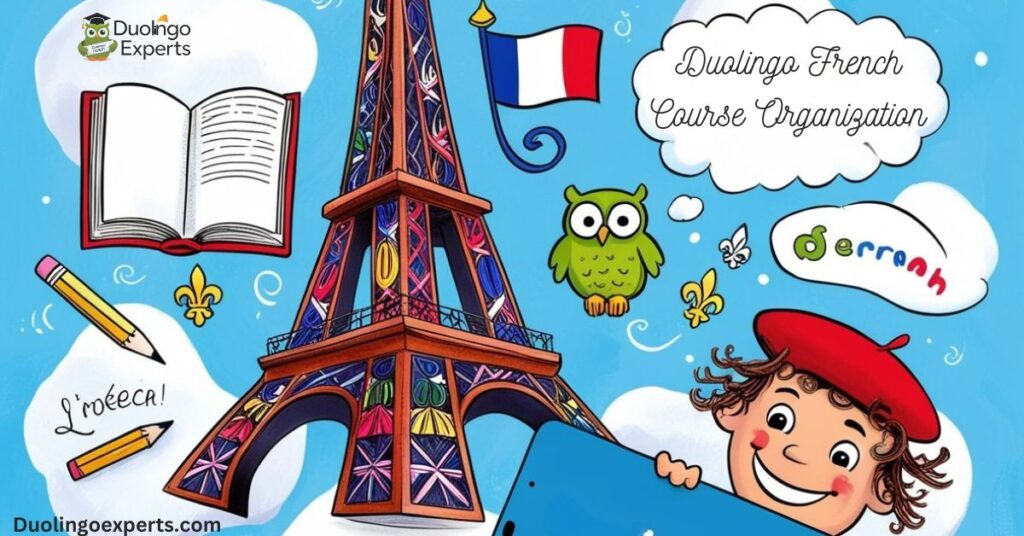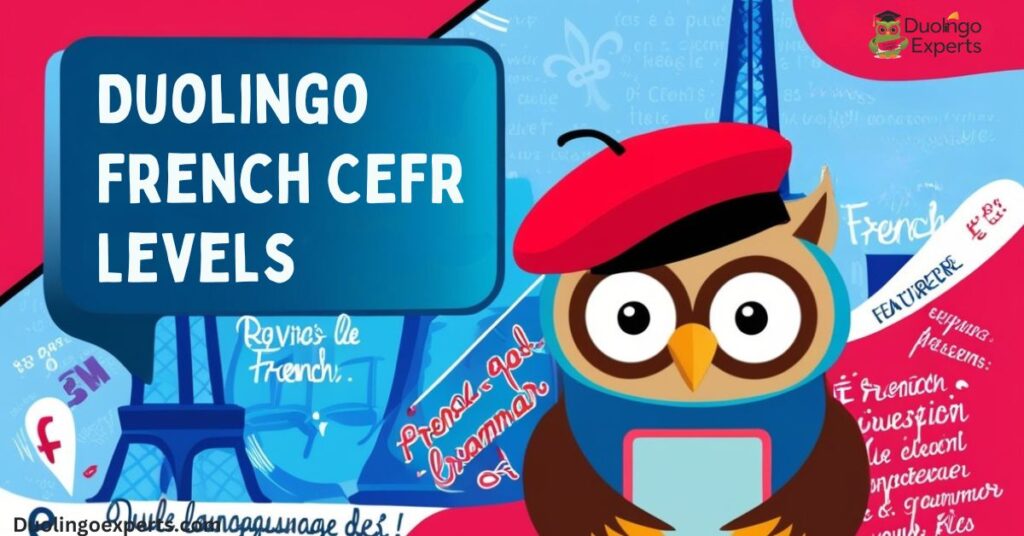How Many Sections in Duolingo French is an important question for anyone starting the language journey. Duolingo is one of the most widely used language learning platforms in the world, offering a fun, engaging way to learn a variety of languages, including French. Whether you’re just starting out or looking to advance your skills, understanding How Many Sections in Duolingo French is key to navigating the app and making the most of its lessons.
If you’ve ever asked yourself, “How many sections are there in Duolingo French?” you’re not alone. Duolingo has designed its French course to be progressive and structured, with each section helping learners build upon their knowledge gradually. In this article, we will answer the question about how many sections there are in Duolingo’s French course, explore each section in-depth, and look at the Duolingo curriculum as it aligns with the CEFR levels (Common European Framework of Reference).
We’ll also touch on Duolingo’s progress tracking, gamification features like XP points, streaks, and leagues, and give you strategies for navigating the app effectively to help you reach French fluency. By the end of this article, you’ll have a clear understanding of the Duolingo French course structure, how many sections are involved, and how to stay on track in your French language learning journey.
Understanding Duolingo French Course Organization

Duolingo’s French course is designed with a structured approach that guides learners through all levels of proficiency. Whether you’re a complete beginner or someone with some knowledge of French, Duolingo helps you progress step by step, with each section and unit carefully crafted to build your language skills progressively.
Course Structure: Sections, Units, and Lessons
The Duolingo French structure is based on sections, each containing multiple units. Within each unit, you will find lessons that cover a range of topics, from basic vocabulary to advanced grammar. The sections are the larger categories of the course, while units focus on specific subtopics such as conjugation, pronunciation, or word order.
In total, the French course on Duolingo consists of 9 main sections, each carefully designed to lead you from beginner to intermediate proficiency in French. The app uses a gamified learning environment where you progress through lessons and units, earn XP points, and gain crowns as you master new skills.
Each section is meant to be completed in a linear fashion, but Duolingo also allows you to review past lessons to ensure that you don’t forget previously learned content. It’s this spaced repetition system that helps reinforce your understanding and ensures that your progress is sustainable.
CEFR Alignment and Language Proficiency
Duolingo aligns its French course with the Common European Framework of Reference (CEFR), a widely recognized standard for measuring language proficiency. The CEFR levels range from A1 (beginner) to C2 (proficient). While Duolingo’s French course doesn’t cover the full range of levels, it offers structured learning from A1 to B2 levels, which represent beginner to upper-intermediate proficiency.
Each section within the Duolingo French course helps you gradually build your proficiency level. For example, completing the early sections will help you reach an A1 level (beginner), while more advanced sections will propel you towards B1 and B2 levels.
How Many Sections in Duolingo French?
Let’s get to the core question How many sections are there in Duolingo French? As mentioned, the Duolingo French course consists of 9 main sections, and each section consists of a series of units that cover specific aspects of the language. These sections are structured in a way that helps learners develop the necessary skills to become conversationally fluent in French by the time they finish the course.
Here’s a detailed breakdown of each of the 9 sections:
| Section | Focus |
|---|---|
| 1. Rookie | Introduction to basic vocabulary and phrases |
| 2. Explorer | Expanding vocabulary, introduction to basic grammar |
| 3. Traveler | Focus on conversational French and common expressions |
| 4. Navigator | Intermediate grammar and vocabulary building |
| 5. Champion | Advanced vocabulary and grammar concepts |
| 6. Extension | More complex topics, including past and future tenses |
| 7. Discoverer | Refining grammar and expanding understanding of nuanced language |
| 8. Trailblazer | Mastering advanced sentence structures and conversational fluency |
| 9. Explorer (Final) | Final push for mastery, covering all grammar and vocabulary topics |
In-depth Breakdown of Each Section
- Rookie Section:
The Rookie section is where you begin your French language learning journey. This section is designed for beginners and introduces the most basic vocabulary and phrases needed to communicate in French. You’ll learn greetings, how to introduce yourself, and how to ask and answer simple questions. The primary goal of this section is to familiarize you with the French alphabet and basic sentence structures. Key topics include:- Basic greetings (Bonjour, Salut, etc.)
- Simple verbs like être (to be) and avoir (to have)
- Numbers and common nouns
- Explorer Section:
In the Explorer section, the focus shifts to expanding your vocabulary and introducing you to basic grammar concepts. You’ll learn how to express preferences, describe simple actions, and give directions. Key topics include:- Introduction to adjectives
- Basic sentence structure and word order
- Simple questions and negations
- Traveler Section:
As you advance to the Traveler section, you’ll learn how to communicate more effectively in practical situations, like ordering food, talking about your routine, or making small talk. It’s a conversational-based section that focuses on helping you feel more confident in real-world situations. Key topics include:- Talking about daily activities
- Making purchases and ordering in restaurants
- Using common prepositions (on, under, with)
- Navigator Section:
The Navigator section is where things start to get more serious. You’ll dive into more intermediate grammar and start using more complex verb tenses, such as the future tense and conditional statements. This section lays the foundation for more advanced grammar. Key topics include:- Introducing the future tense
- Using the conditional
- Refining your understanding of articles (definite, indefinite)
- Champion Section:
This section introduces advanced vocabulary and complex grammar. Here, you’ll learn how to express yourself in more nuanced ways and explore topics like expressing opinions and giving advice. Key topics include:- Mastering irregular verbs
- Using the subjunctive mood
- Refining your speaking and writing skills
- Extension Section:
The Extension section delves into more advanced grammatical structures like past tenses, including passé composé. You’ll learn how to talk about past events and express yourself with more precision and fluency. Key topics include:- Understanding passé composé and imparfait
- Talking about actions that happened before a certain time
- Complex sentence structures
- Discoverer Section:
This section introduces cultural aspects of French language and explores more abstract topics. You’ll refine your understanding of complex grammar and focus on expressing yourself in more emotional or subjective ways. It’s about using language more naturally. Key topics include:- Cultural expressions and idiomatic phrases
- Dealing with emotions and complex feelings
- Understanding the use of different pronouns
- Trailblazer Section:
The Trailblazer section is designed to push you to mastery. You will encounter more complex sentence structures and begin learning how to hold debates, express complex opinions, and tackle discussions on various topics in-depth. Key topics include:- Advanced sentence structures
- Expressing detailed opinions
- Fluent conversation practice
- Explorer (Final):
The final section is a cumulative one that revisits the most important concepts from previous sections. It ensures that you’re ready for the B2 level by covering all grammar and vocabulary points and helping you tie them together for fluency. Key topics include:- Full review of vocabulary and grammar
- Practical fluency exercises
- Real-life conversations and scenarios
Duolingo French CEFR Levels

As you progress through the Duolingo French course, you’ll notice that the CEFR levels are an integral part of the app’s design. Each section aligns with different levels of proficiency, ensuring that you’re progressing steadily from beginner to intermediate.
| CEFR Level | Proficiency | Duolingo French Section Focus |
|---|---|---|
| A1 | Beginner – Understand and use everyday expressions | Rookie, Explorer, Traveler |
| A2 | Elementary – Can communicate in simple and routine tasks | Navigator, Champion |
| B1 | Intermediate – Can deal with most situations while traveling | Extension, Discoverer |
| B2 | Upper-intermediate – Can produce detailed text and take part in conversations | Trailblazer, Explorer (Final) |
Completing the Champion section will likely bring you to B1 level, while finishing the Explorer (Final) section may get you closer to the B2 level, depending on your progress and practice.
Duolingo French Progress Tracking
Duolingo uses a system of XP points to measure progress and motivate users. Each lesson, unit, or section completed rewards you with XP points, which can contribute to your overall level within the app. This progress tracking system helps you stay motivated and provides a way to measure how far you’ve come.
In addition to XP points, Duolingo also offers streaks (the number of consecutive days you’ve practiced) and leagues (friendly competitions with other learners). These tools add a layer of gamification that makes language learning fun and rewarding.
Time Requirements for Each Section
The amount of time you’ll spend in each section depends on how quickly you progress and how much time you dedicate to learning. Generally, beginners can expect to spend several weeks in the Rookie and Explorer sections, while more advanced sections like Champion and Explorer (Final) might take a few months to fully complete.
In addition, Duolingo offers a daily routine that helps you stay on track. Completing a few lessons every day is key to maintaining consistent progress.
Frequently Asked Questions
How many sections are in Duolingo French?
The Duolingo French course consists of 9 sections in total. Each section is designed to help learners progress from beginner to intermediate levels of proficiency.
How many sections are there in Duolingo French in 2025?
In 2025, the Duolingo French course still consists of 9 sections. These sections guide learners from basic vocabulary to advanced fluency in French.
How many sections does Duolingo have for French?
Duolingo offers 9 sections for French learners. These sections cover a range of topics, from beginner to intermediate levels of proficiency.
How long does it take to complete Duolingo French?
The time it takes to complete Duolingo French depends on your pace, but it typically takes several months for consistent learners. On average, completing the entire course may take around 6 to 12 months.
What level does Duolingo French go up to?
Duolingo French takes learners up to a B2 level, which is upper-intermediate proficiency. This level allows for confident conversation and understanding of complex French topics.
Can you reach C1 with Duolingo?
Duolingo French does not fully cover the C1 level, as its course typically ends at B2. However, with additional practice and exposure, you can continue to improve beyond Duolingo to reach C1.
Is Duolingo French enough?
Duolingo French provides a solid foundation in the language, but to reach advanced fluency, it’s beneficial to complement it with other resources. Practice with native speakers and immersion experiences can help further your skills beyond Duolingo.
What is level B1 in French?
Level B1 in French represents an intermediate proficiency, where you can handle everyday situations, express opinions, and understand main points in conversations. It’s a solid stage for conversational fluency and traveling in French-speaking regions.
What is the simplest language to learn?
The simplest language to learn depends on your native language, but languages like Spanish and Italian are often considered easier for English speakers due to similar vocabulary and grammar structures. Esperanto is also designed to be highly accessible and easy to learn for anyone.
What level of Duolingo is A1?
In Duolingo, A1 is the beginner level, where learners start with basic vocabulary and simple sentence structures. It’s the foundation for understanding and using common phrases in everyday situations.
Conclusion
Understanding how many sections are in the Duolingo French course and the structure behind them is crucial for anyone serious about mastering the language. With 9 distinct sections, each building upon the last, Duolingo’s French curriculum offers a comprehensive and fun learning journey that will help you develop fluency in the language.
By working through these sections, tracking your progress, and maintaining a regular study routine, you’ll be well on your way to mastering French through Duolingo. Whether you’re a beginner aiming for A1 proficiency or an intermediate learner looking to reach B2, Duolingo provides all the tools and features you need to succeed.
>>>Read Also: What Kind of Chinese Does Duolingo Teach? Features & Course Review

DuolingoExperts, managed by MarkJohan, offers expert insights and tips for mastering languages. A tech-driven platform to enhance your learning experience.

